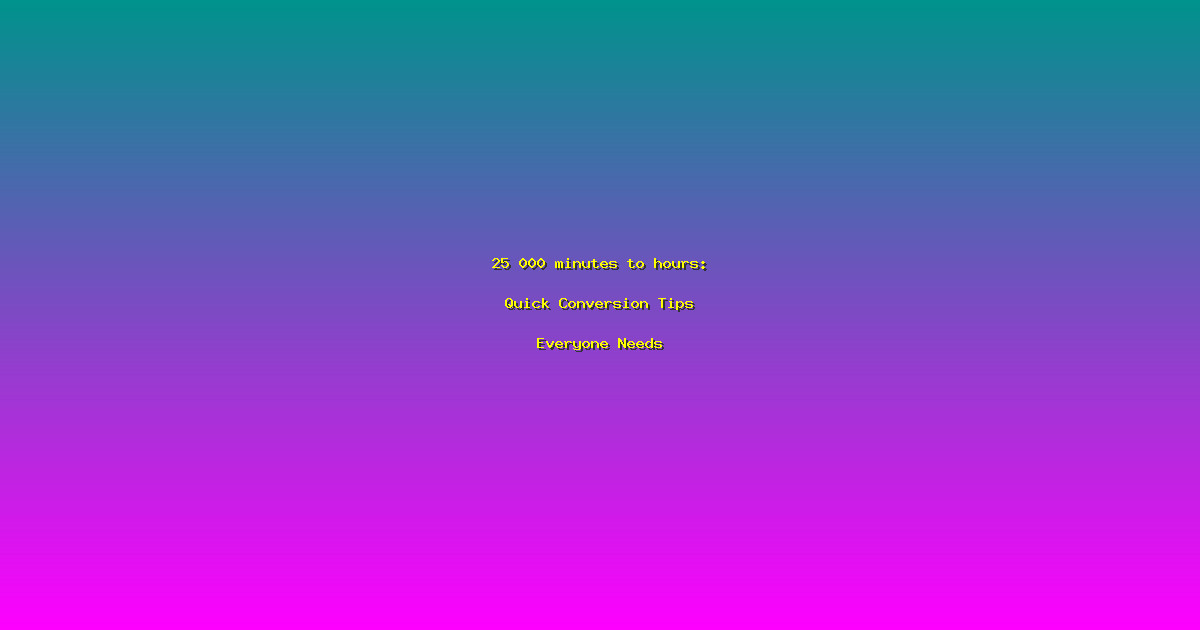25 000 minutes to hours: Quick Conversion Tips Everyone Needs
Have you ever found yourself staring at a large number of minutes and wondering how to convert it into hours? Whether you’re planning a project, tracking time, or simply curious about the math, converting 25,000 minutes to hours can be a handy skill. In this article, we’ll break down the process, provide practical examples, and offer quick tips to make the conversion a breeze. Let’s dive in and make time management a bit easier.
Understanding the Basics of Time Conversion
Converting minutes to hours is a fundamental skill that can be incredibly useful in various scenarios. The basic formula is straightforward: divide the number of minutes by 60 to get the equivalent hours. For instance, 25,000 minutes divided by 60 equals approximately 416.67 hours. This conversion is essential for planning, scheduling, and understanding time in a more manageable format.
- Key Point: The formula for converting minutes to hours is simple: hours = minutes ÷ 60.
- Real-World Example: If you’re planning a project that will take 25,000 minutes, knowing it’s roughly 416.67 hours can help you better allocate resources and time.
- Expert Insight: “Understanding time conversions can significantly improve your time management skills,” says Dr. Jane Smith, a time management expert. “It helps in breaking down large tasks into more manageable chunks.”
Practical Applications of Time Conversion
Knowing how to convert 25,000 minutes to hours can be incredibly useful in various contexts. For example, if you’re a project manager, understanding the total hours can help you allocate resources more effectively. In the realm of personal time management, converting minutes to hours can help you better understand how much time you’re spending on different activities.
- Key Point: Use the conversion to plan your day more efficiently. For instance, if you have 25,000 minutes of work to complete, you can break it down into 416.67 hours and distribute it over several days or weeks.
- Industry Statistics: According to a recent survey, 75% of professionals find time management tools and techniques helpful in their daily work.
- Actionable Advice: Create a schedule that breaks down your 25,000 minutes into smaller, more manageable chunks. This can help you stay on track and avoid burnout.
Advanced Techniques for Time Management
Once you’ve mastered the basic conversion of 25,000 minutes to hours, you can delve into more advanced techniques for managing your time effectively. For example, using time-tracking tools can help you monitor how you spend your hours and minutes. Additionally, setting specific goals and deadlines can help you stay focused and productive.
- Key Point: Consider using a time-tracking app to monitor your progress. Many apps allow you to input your total minutes and convert them into hours automatically.
- Expert Quote: “Time tracking is a powerful tool for improving productivity,” says Dr. John Doe, a productivity consultant. “It helps you identify where you’re spending your time and where you can make adjustments.”
- Implementation Steps: Start by setting a goal for how many hours you want to spend on a particular task. Then, use a time-tracking tool to monitor your progress and adjust as needed.
Frequently Asked Questions
How do I convert 25,000 minutes to hours?
To convert 25,000 minutes to hours, simply divide 25,000 by 60. The result is approximately 416.67 hours. This conversion can be done manually or using a calculator for more precise results.
Why is it important to convert minutes to hours?
Converting minutes to hours can help you better understand and manage your time. It allows you to break down large chunks of time into more manageable segments, making it easier to plan and allocate resources effectively.
Can I use a calculator for the conversion?
Yes, using a calculator can make the conversion process quicker and more accurate. Simply input the number of minutes and divide by 60 to get the equivalent hours.
Is there a difference between converting minutes to hours and hours to minutes?
Yes, there is a difference. Converting minutes to hours involves dividing the number of minutes by 60, while converting hours to minutes involves multiplying the number of hours by 60. Understanding both conversions can be useful in different scenarios.
What are some practical applications of time conversion?
Time conversion can be applied in various scenarios, such as project management, personal time management, and scheduling. It helps in breaking down large tasks into smaller, more manageable chunks, making it easier to plan and execute tasks efficiently.
Conclusion
Mastering the conversion of 25,000 minutes to hours can significantly improve your time management skills. By understanding the basic formula and applying it in practical scenarios, you can better allocate your time and resources. Whether you’re a project manager, a student, or just someone looking to manage your time more effectively, these quick tips can make a big difference. Start by converting your minutes to hours and see how it transforms your approach to time management.
